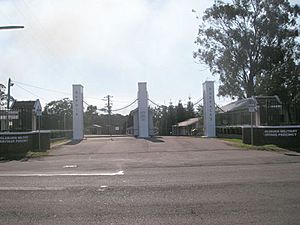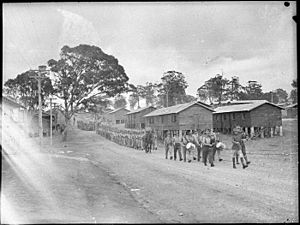Ingleburn Military Heritage Precinct and Mont St Quentin Oval facts for kids
Quick facts for kids Ingleburn Military Heritage Precinct and Mont St Quentin Oval |
|
|---|---|
 |
|
| Location | Campbelltown Road, Ingleburn, Sydney, New South Wales, Australia |
| Built | 1939–1998 |
| Owner | Landcom |
| Official name: Ingleburn Military Heritage Precinct and Mont St Quentin Oval; Ingleburn Army Camp | |
| Type | state heritage (complex / group) |
| Designated | 15 March 2013 |
| Reference no. | 1891 |
| Type | Defence Base Army |
| Category | Defence |
| Lua error in Module:Location_map at line 420: attempt to index field 'wikibase' (a nil value). | |
The Ingleburn Military Heritage Precinct and Mont St Quentin Oval is a special historical place in Ingleburn, near Sydney, Australia. It was once a very important army training camp. Many of its old buildings were built starting in 1939. This site is now protected for its history and was added to the New South Wales State Heritage Register in 2013.
Contents
A Look Back at Ingleburn's Army Camp
The Ingleburn Army Camp was first set up in 1939 on a large piece of land. It grew even bigger over time. This site played a huge role in Australia's military history.
How the Camp Started
Much of the land for the camp was originally given to James Meeham in 1816. Later, it was bought by Samuel Terry in 1831. The land was divided up over the years. By 1939, when World War II began, the government needed a big new training camp.
Australia joined World War II in September 1939. Many people volunteered for the army. This meant Australia needed many new places to train soldiers. The existing training site in Liverpool wasn't big enough. So, Ingleburn was chosen as the perfect spot for a new, purpose-built army training camp.
The government bought the land for the camp in 1940. However, the first soldiers arrived on November 1, 1939, even before all 333 buildings were finished! The camp had everything soldiers needed. This included places to sleep, eat, and train. There were also offices and medical areas. Most of the sleeping and office buildings were simple wooden huts.
Training Soldiers for War
Soldiers at Ingleburn received basic training. They learned to work together as a team. Ingleburn was also key in forming army units before they went to war. For example, the 16th Brigade of the 6th Division was formed here. They were the first Australian troops to fight in World War II. They fought bravely in the Battle of Bardia in 1941. Another famous group, the 2/13th Battalion, also formed at Ingleburn. They were known for their tough fighting during the Siege of Tobruk.
The Mont St Quentin Oval was first used as the main parade ground. This is where soldiers marched and were officially sent off to war. It was also where they were welcomed back home. Many soldiers were also released from service here after the war.
In 1941, the Australian Women's Army Service started. Ingleburn began training women too. They learned important jobs like driving military trucks and working in offices. Ingleburn also had a hospital that trained medical units.
After World War II
After World War II ended, the camp became quieter. Some land was even leased to local farmers. But it still remained an army base. It became home to different army battalions over the years.
When Australia got involved in the Korean War (1951-1953), Ingleburn became busy again. More soldiers were trained here. The camp also added housing for married soldiers and their families. Villages like Bardia and Valley View were built. A childcare center called Bambi Creche was even set up by soldiers' wives. It helped families by looking after children.
Ingleburn also became a major training center for the National Service scheme in 1951. This meant all young men had to do military training. The camp grew with new sports fields and recreation areas.
During the Vietnam War, Ingleburn continued to train soldiers. It also became linked to the anti-war movement. Some people who refused to fight were held in the camp's guard house. In 1972, National Service ended. From 1973 to 1998, Ingleburn trained the Australian Army Reserve. The camp closed down by the year 2000.
The Military Heritage Precinct Today
The Military Heritage Precinct was created in 2002. It's a special area that keeps important buildings and memorials safe. It helps people remember the camp's history. This precinct is a place for ceremonies and visits.
It has memorials, the old guard house, and cell blocks. There's also the former Chaplain's Office and Post Office. You can also see three P1 huts, which were common army buildings. Some of these huts were built in the 1950s and are linked to the Korean War. Others are older, from World War II. One of the old huts is now a museum.
The main entrance gates with their brick sentry posts are also part of the precinct. They were built early in World War II. The cell block, with its ten cells, was added in 1949.
Important Memorials
The precinct has several memorials that honor those who served.
- A "Memorial Grove" of pine trees was planted in 1987. It remembers soldiers who died while serving at Bardia Barracks.
- A memorial for National Servicemen was opened in 1997. It's a place for yearly events.
- A memorial wall built in 2002 remembers all infantry and training groups that served at Bardia Barracks.
- A paved area shaped like the "Rising Sun" badge honors the 16th Brigade. This group first gathered at Ingleburn in 1939 and fought bravely in many places.
- A concrete statue of a soldier was moved here in 2008. It was first unveiled in 1923.
The former Chaplain's Office is now used for school visits and meetings. The old military Post Office is also used by visitors and members of the National Servicemen's Association.
Mont St Quentin Oval
The Mont St Quentin Oval is across the road from the Military Heritage Precinct. It was a sports field before the army camp started. It was also the camp's first parade ground. Later, it became a recreation area for soldiers. The old gates from the camp's hospital were moved to the oval after the hospital was taken down in 1997.
What You Can See at the Precinct
The Military Heritage Precinct is surrounded by a fence. It includes the original white gateposts and guard posts of the Bardia Barracks.
The main entrance gates have two red brick sentry boxes. These small buildings have white roofs. Behind the gates is a timber guard station. The gates themselves are tall white pillars with "BARDIA" and "BARRACKS" written on them. The entrance driveway has low red brick walls and plants.
Buildings and Structures
The Guard House
The guard house and its cell block are near the entrance gates. The guard house was built in 1939. It's a timber building with a green roof. It has a veranda at the front. It's now used as a small kitchen and break area for security staff.
The Cell Block
The cell block was added in 1949. It's behind the guard house and has a concrete exercise yard. It has 10 cells with heavy wooden doors. The cells still look much like they did originally.
Former Chaplain's Office
This building is made of weatherboard and is slightly raised off the ground. It has a new metal roof. It's a single room that still has its original windows and doors. It's now used for education and meetings.
Former Military Post Office
This building used to be a P1 type hut from the 1950s. It has a sloped roof and a veranda. It's also a single room with weatherboard on the outside. It has benches and ramps for easy access.
P1 Type Huts
There are three similar P1 type huts in the precinct. They are painted cream and brown with grey roofs. These huts show what typical army barracks looked like. They are called Huts 1, 2, and 3.
Huts 2 and 3 are older, from 1939-1946. They have doors at each end and three windows. Hut 3 is now a museum. It shows a soldier's bed, uniforms, and old photos. Hut 1 is a newer P1 hut from the 1950s. It has different windows and its doors are on the side. Huts 1 and 2 are currently used for storage.
Mont St Quentin Oval
This oval is managed as part of the heritage precinct. Its entrance is marked by the original oval gate posts. The old hospital gates were moved here too. The oval still has the viewing stand and steps from when it was a parade ground during World War II.
Condition of the Buildings
Most of the buildings, like the guard house, cell block, and huts, are in good condition. They have been well-maintained. The guard house and cell block still have their original layout. The Chaplain's Office and Post Office also keep their original windows and doors. Hut 3, the museum, has not had many changes.
Why Ingleburn is Important
The Ingleburn Military Heritage Precinct and Mont St Quentin Oval are very important to New South Wales history.
It was the first army training camp built specifically for World War II. It was also where the first Australian troops for World War II were formed. The Mont St Quentin Oval was likely the first parade ground where soldiers were farewelled. This site helped train and send off soldiers for many wars in the 20th century.
The site is also important because of its links to famous army units. These include the 16th Brigade and the 2/13th Battalion, who fought bravely. It also has links to the Korean and Vietnam Wars. It even shows how society changed during the Vietnam War, with the anti-war movement.
Ingleburn is special to many former soldiers. It represents their army experiences. The entrance gates and sentry boxes symbolize starting army life. The Military Heritage Precinct also shows what a typical large army training camp looked like in Australia. The huts, guard house, and parade ground show how these camps worked.
The site is a place where people remember and honor military service. The memorials are important places for soldiers, their families, and the community to reflect.


